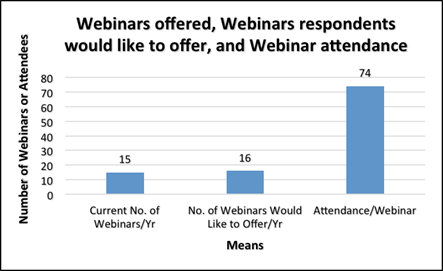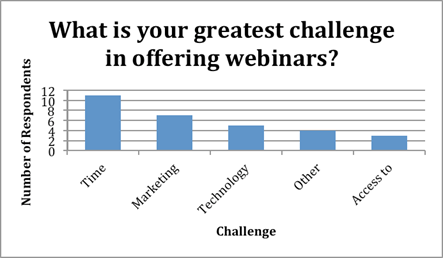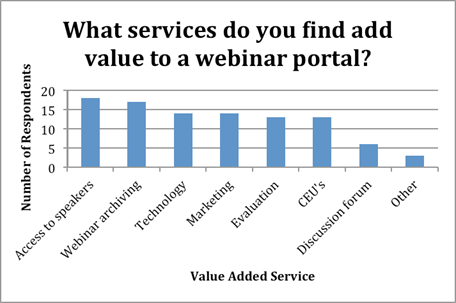 |
December 2014
|
December 2014 // Volume 52 // Number 6 // Research In Brief // v52-6rb4
Using Survey Responses to Determine the Value-Added Features of a Webinar Portal System for Adoption by Natural Resource Professionals
Abstract
This article presents the findings of a recent survey of natural resource webinar providers. Respondents were asked a range of questions regarding their webinar services. Findings showed that respondents most commonly marketed their webinars through email or websites and targeted an audience of professionals. Respondents noted that the greatest challenge in offering webinars was the time commitment, whereas access to high-quality speakers added the most value to a webinar portal. Although the majority of responding webinar providers do not currently charge for their webinars, over one third noted that they would be willing to pay a fee per participant.
Introduction
Tighter fiscal environments and increasing workloads have combined with improved technology to offer many natural resource professionals the opportunity to use online sources to serve their clients. With over 85% of adults using the Internet daily (Pew, 2013), natural resource professionals recognize the need to reach out and connect with traditional and non-traditional clientele via the Internet. One popular Internet technology, Web conferencing (i.e., webinars and online workshops), can fulfill many clients' professional continuing education units, which are required to maintain compliance with their professional organizations and/or regulating agency. Web conferencing can also satisfy information and knowledge needs of those not wanting continuing education units. Web conferencing allows real-time communication of text-, voice-, graphic-, and video-based content between the participants (clients) and the disciplinary expert across geographically dispersed locations that would be too great of a distance for frequent face-to-face events. In general, webinar participants are satisfied with webinar programs (Rich et al., 2011) and see the benefit of information learned to their lives (Young, Weinert, & Spring, 2012).
When webinars are offered in both real-time (live) and as pre-recorded sessions (archived), they can provide clients training at their convenience 24 hours a day while eliminating the need for event-specific travel. A "webinar portal" is a convenient website that combines the information regarding links to live and searchable "on-demand" webinars with a number of "value added" features for offering webinars. Webinar portals such as http://forestrywebinar.net can provide a "one-stop shop" for advertising, offering, and archiving the webinars and can also automate the process of marketing, registration, pre- and post-surveys, quizzes, "green savings," evaluation and impact results, and the continuing education process. North Carolina State University in collaboration with Texas A&M Forest Service and the Southern Regional Extension Forestry office conducted a survey of natural resource webinar providers to find out more about the services they offer and how a portal could add value to current efforts.
Method
An online survey was used to determine the potential value and interest in using a webinar portal service. To conduct the survey, a comprehensive list of natural resource webinar providers throughout the United States was developed through personal discussion and an Internet search by a North Carolina State University graduate student under the leadership of a guiding team for a United States Department of Agriculture National Institute of Food and Agriculture Renewable Resources Extension Act (RREA) grant. The guiding team included 12 natural resource professionals throughout the U.S. who offered oversight to the RREA grant entitled, "Expanding the Reach of Extension with Webinar Technologies and Social Media." Team members consisted of research and academic Extension, non-governmental natural resource, and United States Forest Service professionals. For each webinar provider, information was gathered on webinars provided, types of continuing education credits offered, and contact information for the webinar provider. The final list was comprised of 92 natural resource webinar providers.
The survey, administered using Qualtrics, a Web-based tool for building surveys, consisted of 23 questions and included both multiple choice and open-ended questions. The survey was reviewed by the guiding team, faculty at North Carolina State University, and the Institutional Review Board for the Use of Human Subjects in Research at North Carolina State University before it was sent to webinar providers. The survey was administered via email to all 92 natural resource webinar providers. Webinar providers were sent up to two emails to request their input between April 2, 2013 and July 4, 2013.
A total of 31 out of 92 webinar providers returned their surveys, which provided a response rate of 34%. The overall response rate for an Extension, in-house, web-based surveys is 48.3% (Archer, 2008); however, providers surveyed for the project reported here included providers both in-house and external to Extension. Past Journal of Extension articles have addressed nonresponse error by comparing early and late respondents or respondents and non-respondents (Lindner & Wingenbach, 2002). For this survey, early respondents were considered as individuals who responded after the first email but before the second email, while late responders were considered as individuals who responded to the survey after the second email. Responses for early and late responders were compared using the SAS t-test for the following quantitative questions.
- On average, how many webinars per year do you/your organization currently provide?
- How many webinars per year would you like to provide?
- Consider your past webinars. Please specify the lowest number of participants, the average number of participants, and the greatest number of participants for webinars you have provided.
The early and late responders were not statistically different (p > .01) for any of the above questions. Therefore, non-response rate error is not expected to affect the external validity of this study. For comparison, survey results are summarized using descriptive statistics and are organized into the following five categories:
- Services offered with webinars
- Webinars provided
- Challenges to offering a webinar
- Value and benefits of utilizing a webinar portal
- Costs
Results
Services Offered with Webinars
Webinar providers were asked to select all that apply to how they market their webinars. Most respondents marketed their webinars through e-mail and websites. Websites employed to market webinars included education and professional websites. No overlap was noted in the websites used. Over half of the providers surveyed also employed some type of social media (Facebook, Twitter, LinkedIn) to market their webinars (Figure 1).
Figure 1.
How Respondents Marketed Webinars

Respondents were asked whether they offered continuing education units (CEU's). The majority of respondents (17) offered CEU's; CEU's offered included Society of American Foresters, International Society of Arboriculture, The Wildlife Society, and Certified Crop Advisor. Webinar providers were also asked which methods they used to evaluate their webinars. Nineteen out of 30 respondents noted some type of evaluation. Methods respondents stated for evaluating webinars included pre/post quizzes, surveys, polls, and informal feedback. Furthermore, respondents were asked whether clients were able to rate webinars. Almost half of the respondents (14/30) stated that they allowed participants to rate the webinars.
Webinars Provided
Webinar providers were asked about the number of webinars they currently offer and the number of webinars that providers would like to offer. The results showed that the mean number of webinars currently provided per year by webinar provider was 15, while the mean number of webinars that providers would like to offer per year was 16. Respondents were also asked to consider their past webinars and to specify the lowest number of participants, the average number of participants, and the greatest number of participants for webinars they had provided. The means for low, average, and greatest number of participants per webinar were 26, 74, and 160 participants per webinar respectively. The means for number of webinars currently provided per year, number of webinars respondents would like to provide per year, and the attendance per webinar are shown in Figure 2.
Figure 2.
Mean Number of Webinars Currently Provided per Year, Mean Number of Webinars Providers Would Like to Offer/Year, and Mean Number of Attendees per Webinar

Challenges to Offering a Webinar
Respondents were asked to note the greatest challenge to offering a webinar. Choices included time commitment, marketing, access to high-quality speakers, evaluation, technology, and other. The number one challenge to offering webinars according to the respondents was time commitment. Respondents also noted marketing, technology, and access to high-quality speakers as challenges. However, no respondents stated that evaluation was the greatest challenge (Figure 3).
Figure 3.
Respondents' Greatest Challenge to Offering Webinars

Value and Benefits of Using a Webinar Portal
Respondents were asked to choose services that added value to a webinar portal. Respondents could select all that apply from the following list:
- Access to high-quality speakers
- Marketing support
- Evaluation support
- Continuing education credit support
- Discussion forum (external to the webinar)
- Webinar archiving
- Technology support
- Other
Respondents most often chose high-quality speakers as valuable when using a webinar portal, followed directly by webinar archiving, technology support, and marketing support (Figure 4).
Figure 4.
Webinar Services Found Valuable by Respondents

Respondents were then asked to choose the most valuable service for webinar portals from the referenced list of value added services. Access to speakers and webinar archiving were favored by the respondents as adding the most value in general to webinar portals. These services were followed closely by marketing and technology (Figure 5).
Figure 5.
Most Valuable Service to Webinar Portal from List of Value Added Options

Costs
Webinar providers were asked whether they charged for their webinars. Seventy-four percent of the respondents did not charge for their webinars (n=23). Respondents who noted a cost for webinars replied that the costs ranged from $9 to $30/credit hour. Due to privacy, costs were not associated with particular entities/participants. However, a cross tabulation analysis was conducted to determine if there was a correlation between the participants that charged for their webinars and the following:
- How participants market the webinar
- Whether participants offered CEU's
- If the providers were required to pay for the webinar system that they used
The cross tabulation results did not indicate significant relationships between any of the listed factors.
Respondents were also asked through an open-ended question how much money they would be willing to pay per participant for a webinar portal with the referenced value added components. Only 12 respondents answered this question with an actual dollar amount. The costs ranged from less than $1/participant to $25/participant. The mean cost was $4.76/participant for respondents answering this question. Using the mean number of webinar participants per webinar from this survey (74) and the mean cost that participants were willing to pay, an average price of $352 per webinar was calculated.
Discussion
As the use of webinars increases, there will be opportunities to collaborate among webinar providers to develop more effective and efficient mechanisms to serve clients. The number one challenge to offering webinars based on this survey is time commitment. Webinars take time to organize, market, conduct, archive, and evaluate. In addition to being more efficient by collaborating on time saving tasks, opportunities exist to add value to the services that webinar providers currently provide through a common webinar portal, outlet or service.
A common webinar portal that automatically registers and tracks continuing education credits with accreditation sources can be a time saver to the webinar provider and a valuable service for the webinar user. Tracking the economic and environmental savings of webinars is important during tight fiscal environments, because webinars save time, energy, and money. These savings can easily be tracked through an automated system and relayed back to the webinar provider making the case for funding of future webinars more simple. Access to speakers and archiving were noted by respondents as services adding the most value to a webinar portal. The use of a common webinar portal will connect multiple webinar providers together, offering more opportunities for clients to access high-quality speakers via both live and archived webinars in one convenient website. Adding a rating system to the portal will better educate users on webinars that meet their needs. Finally, the costs of providing webinars should be considered to ensure long-term financial stability. While many webinars are subsidized or provided free of charge by universities, Extension, the private sector, and others, it is important to consider the willingness to pay by webinar users. Providing a system for cost recovery for webinars through a common webinar portal may be necessary for ensuring high-quality webinars can be offered in the future.
Conclusion
Webinars are an effective means by which to transfer new and emerging information to natural resource managers and professionals. There has been a proliferation of webinar providers from both the public and private sector. Baseline information of who these providers are, what services they provide, and what services they may need was collected with the objective of potential collaboration and adding value through a common webinar portal. As the numbers increase, a webinar portal can be used to help webinar providers with advertising, offering, and archiving the webinars and can also automate the process of pre-surveys, post-surveys, quizzes, and continuing education credit certification, thus saving the natural resource professional time and money. Among other baseline information items, this article demonstrates challenges, value-added services, and costs for providing webinars. This information will be helpful to webinar providers as they look for ways to improve their online services and possibly collaborate with others to offer enhanced services.
References
Archer, T. (2008). Response rates to expect from web-based surveys and what to do about it. Journal of Extension [On-line], 46(3) Article 3RIB3. Available at: http://www.joe.org/joe/2008june/rb3.php
Lindner, J., & Wingenbach, G. (2002). Communicating the handling of nonresponse error in Journal of Extension research in brief articles. Journal of Extension [On-line], 40(6) Article 6RIB1. Available at: http://www.joe.org/joe/2002december/rb1.php
Pew. (2013). Demographics of internet users. Retrieved from: http://pewinternet.org/Trend-Data-(Adults)/Whos-Online.aspx
Rich, S., Komar, S., Schilling, B., Tomas, S., Carleo, J., & Colucci, S. (2011). Meeting Extension programming needs with technology: A case study of agritourism webinars. Journal of Extension [On line], 49(6) Article 6FEA4. Available at: http://www.joe.org/joe/2011december/a4.php
Young, D., Weinert, C., & Spring, A. (2012). Home on the range-health literacy, rural elderly, well-being. Journal of Extension [Online], 50(3) Article 3FEA2. Available at: http://www.joe.org/joe/2012june/a2.php




